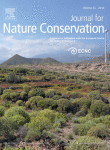Ver ítem
- xmlui.general.dspace_homeCentros Regionales y EEAsCentro Regional Patagonia SurEEA Santa CruzArtículos científicosxmlui.ArtifactBrowser.ItemViewer.trail
- Inicio
- Centros Regionales y EEAs
- Centro Regional Patagonia Sur
- EEA Santa Cruz
- Artículos científicos
- Ver ítem
Biodiversity and ecological long-term plots in Southern Patagonia to support sustainable land management: The case of PEBANPA network
Resumen
Historically, interactions and trends between biodiversity, ecosystem function (EF) and land use practices in southern Patagonia (Argentina) have been largely undocumented and poorly understood. Since 2002, 1214 permanent and semi-permanent plots within the PEBANPA Network have enabled researchers to monitor and assess functions and trends among vegetation parameters, biodiversity, forest dynamics, soil physicochemical characteristics, and land use
[ver mas...]
Historically, interactions and trends between biodiversity, ecosystem function (EF) and land use practices in southern Patagonia (Argentina) have been largely undocumented and poorly understood. Since 2002, 1214 permanent and semi-permanent plots within the PEBANPA Network have enabled researchers to monitor and assess functions and trends among vegetation parameters, biodiversity, forest dynamics, soil physicochemical characteristics, and land use management. The objectives of this manuscript are to communicate the role and rationale of the PEBANPA Network, summarize examples of the main results found within the network and provide guidance to decision makers with respect to advancing sustainable land management in southern Patagonia. As examples, rangeland health indices, seedling and sapling regeneration under different timber managed forests, litterfall and seeds production under silvopastoral use, and soil carbon content impacted by livestock grazing have all been assessed. Vegetation and environmental variables including soil respiration, soil water infiltration, soil water retention capacity, soil erosion, and litter cover were measured under different grazing intensities. Livestock and forestry production have caused changes in the original floristic patterns, with several areas experiencing desertification. Heavy stocking rates have caused the greatest impacts on grassland soil carbon (C) loss as a consequence of soil erosion. We were able to conclude that low − medium grazing intensities yield the most positive impacts for biodiversity and soil physicochemical characteristics. Studies regarding levels of seedling and sapling regeneration post-harvest of timber further supported the importance of long-term monitoring due to the strongest evidence of interactions occurring 20 to 30 years after harvest. Distribution patterns of vascular plants and epigaeic coleopterons diversity revealed statistically significant differences among geographical zones and dominant vegetation types. The PEBANPA Network helps southern Patagonia address the challenges of unsustainable land management and climate change through monitoring ecosystem function and services. Long-term monitoring of biodiversity and ecosystem function help decision makers better understand the impacts of land use practices, develop well-informed policies and secure present and future human well-being.
[Cerrar]

Autor
Peri, Pablo Luis;
Lencinas, María Vanessa;
Bousson, Jeffrey;
Lasagno, Romina Gisele;
Soler Esteban, Rosina Matilde;
Bahamonde, Héctor Alejandro;
Martínez Pastur, Guillermo José;
Fuente
Journal for nature conservation 34 : 51-64. (December 2016)
Fecha
2016-12
ISSN
1617-1381
Formato
pdf
Tipo de documento
artículo
Palabras Claves
Derechos de acceso
Restringido
 Excepto donde se diga explicitamente, este item se publica bajo la siguiente descripción: Creative Commons Attribution-NonCommercial-ShareAlike 2.5 Unported (CC BY-NC-SA 2.5)
Excepto donde se diga explicitamente, este item se publica bajo la siguiente descripción: Creative Commons Attribution-NonCommercial-ShareAlike 2.5 Unported (CC BY-NC-SA 2.5)

